The ASUS ZenPad S (Z580CA) Review
by Brandon Chester on August 31, 2015 8:00 AM ESTBattery Life
The first generation of the iPad promised a ten hour battery life, which was exceptional when one considers what the battery life of smartphones and laptops was at that time. Since that time the battery life target OEMs aim for with tablets has usually hovered around that 10 hour mark. Whether or not a tablet lasts that long obviously depends on a mixture of the user's workload and the OEM's honesty in the battery numbers they report. As for the ZenPad S Z580CA, its 15.2Wh battery is rated for up to 8 hours of battery life by ASUS, which is lower than I would expect when the iPad Mini 2 is competing at the same price with a 10 hour battery life. Of course, the ZenPad S is 0.9 thinner at its thinnest point, which leaves less room to put in battery. This may be one of the cases where I would agree that a thicker device with a larger battery would be better, but that will depend on the outcome of our battery tests.
As always, all devices are calibrated to 200nits for all battery benchmarks, and they follow the standard order of web browsing, BaseMark OS II, PCMark, and finally GFXBench 3.0.

In our WiFi web test the ZenPad S falls about 43 minutes short of its rated 8 hour battery life. Had it been designed for a 10 hour rating this wouldn't be a huge deal as you'd still be talking about nearly 9.2 hours of battery life. However, 7.18 hours is a relatively short battery life for web browsing when you consider that the iPad Mini 2 lasts 9.83 hours in the same test, while the Dell Venue 8 7840 lasts 9.59 hours with the same SoC and a similar display area.
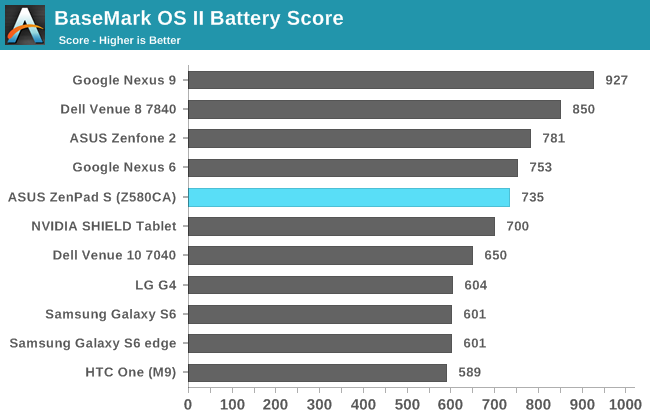

The ZenPad S does fairly well in BaseMark OS II's battery benchmark which mainly stresses a device's CPU. However, it's again outclassed by the Dell Venue 8 7840 which uses the same SoC and actually has a thinner chassis. In this case I would say that the ZenPad S doesn't have bad battery life at all, but I do wish it was a bit higher than it is.
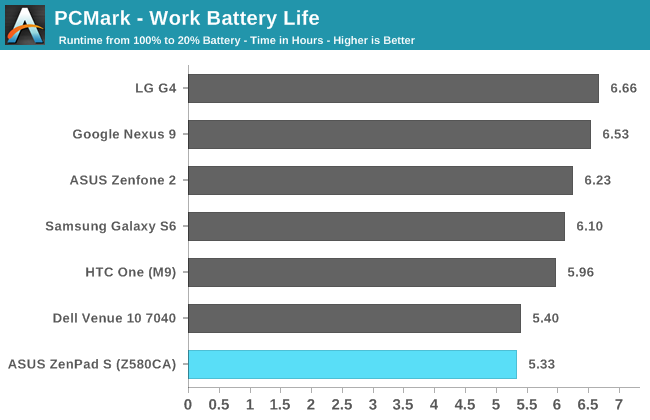
The ZenPad S achieves the shortest battery life of our tested devices in PCMark's battery life test. Although both devices are close, its battery life is slightly shorter than that of the Dell Venue 10 7040, which I repeatedly noted as having extremely poor battery life. PCMark is a fairly good example of the battery life that a user can expected from a mixed workload, and the ZenPad S Z580CA's battery life of 5.33 hours is not quite where it needs to be.
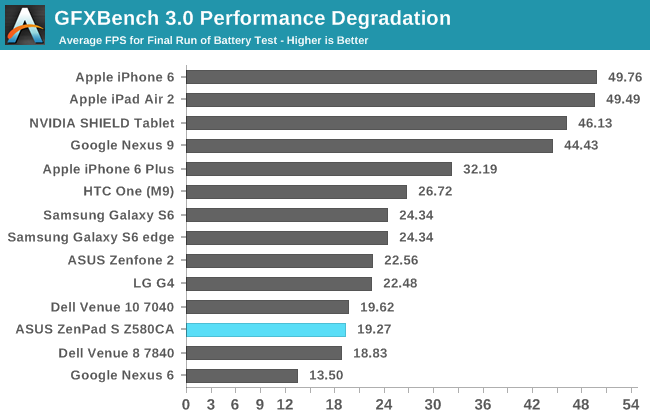
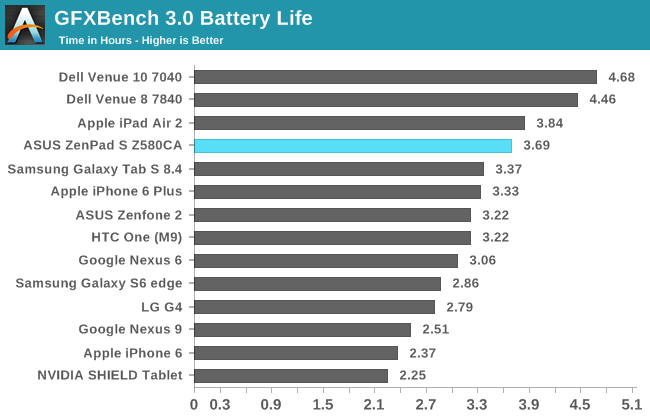
The ZenPad S doesn't last quite as long as the iPad Air 2 in GFXBench's battery test, and sits a little more than 46 minutes behind the Dell Venue 8 7840. Evaluating how well a device does in GFXBench requires considering both the battery life as well as the performance. A device can last a long time but deliver performance that isn't even remotely playable. Conversely, a device can last a short time but have incredible performance, which would still be preferable to a long period of unplayable performance.
With a steady frame rate slightly above 19 FPS for most of the test, the ZenPad S doesn't quite offer smooth performance during the 3.69 hours that it ran for. In comparison, Apple's iPad Air 2 lasted longer and approaches upon 50 FPS, which is well above the 30 FPS that many 3D mobile games target. However, it's also worth noting that this is an on-screen test, and in games that render below a device's native resolution it's entirely possible that the ZenPad S would deliver smooth performance while maintaining its 3.69 hours of battery life. It's also worth noting that the iPad Air 2 costs significantly more than the ZenPad, and while we don't have information about the iPad Mini 2 in this test, it's very likely that its performance would be similar. In the end, the PowerVR G6430 GPU is still a fairly capable GPU, even if it can't run intensive 3D games at 2048x1536. I think the GPU performance and battery life in GPU heavy loads that the ZenPad S offers is more than acceptable for a $300 device.
Charge Time
Since tablets have significantly larger batteries than smartphones, they have always required high power chargers to recharge their batteries in an acceptable period of time. Even so, devices like the 2012 iPad took as long as six hours to charge even with a 10W charger due to the sheer size of their battery. Thankfully, reductions in platform power have allowed for smaller batteries while maintaining battery life, which leads to shorter charging times for tablets. At the moment, most tablets seem to take between 3.5 and 4 hours to charge, and with its 15.2Wh battery one would hope that the ZenPad S could go below that 3.5 hour figure. As you can see above, the ZenPad S doesn't quite meet that goal.
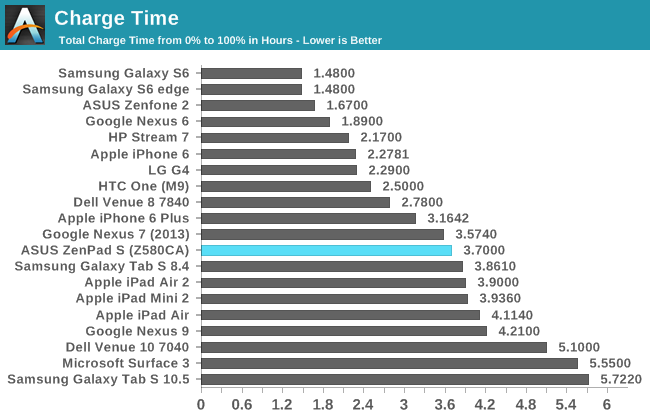
The ZenPad 2 charges slightly quicker than other tablets like the iPad Air 2, iPad Mini 2, Nexus 9, and the Galaxy Tab S 8.4. However, it doesn't charge as fast as the Dell Venue 8 7840. To be honest, I had expected a better result here because of the ZenPad's relatively tiny battery capacity. Dell's included charger provides 7W of power, which isn't as much as the 10W+ bricks that come with iPads and some other tablets. It's worth noting that I also checked the charge time when using ASUS's 18W QC 2.0 power brick, but measured no difference from the one that comes in the box. I would like to note that the lack of QC 2.0 support has absolutely nothing to do with the use of the USB Type-C connector. The USB connector is unrelated to the data and power protocols.
In the end users won't be getting a significant shorter or longer charge time than other tablets, but knowing that the battery is only 15.2Wh has me feeling a bit let down that the ZenPad S takes as long as it does to charge.


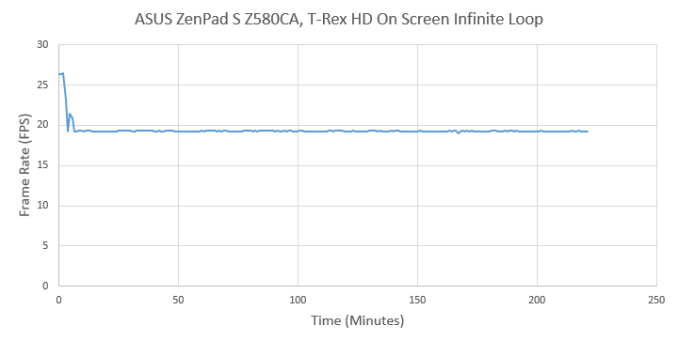








114 Comments
View All Comments
uhuznaa - Monday, August 31, 2015 - link
Things are strange right now: You can get an 8" (retina) iPad Mini 2 for $299 and at the same time Android tablets are either a little bit cheaper and really crappy or more expensive and not really much better.If even Apple is struggling now to sell iPads I somewhat doubt that such Android tablets are selling great now...
retrospooty - Monday, August 31, 2015 - link
I dont know about that. I got the $199 Asus Zenpad S 8 a month ago and am loving it. Like all Androids from OEM's, you really need to spend a bit of time to root it and debloat it to make it shine. Debloated this thing flies. For $199 you get an 8 inch 2048x1536 screen, 32gb storage + SD, great build quality, thin, light, great battery life, fingerprint resistant on all surfaces and the CPU is great as well. I was worried about using an Atom chip, but in actual use, it runs perfectly smooth and cool as well. In fact cooler than any Snapdragon device I have ever used. It doesnt get hot at all, ever and I live in Arizona and it's summer. EASILY the best "bang for your buck" available in a tablet right now from any vendor.MrSavage - Monday, August 31, 2015 - link
@retrospooty, I agree with you. People who review a product at a certain price point who want to compare that to products that are about 1/3 more expensive? Or they simply omit the good features like the 64GB onboard storage in this situation, or the front facing speakers, the stylus support or the microSD slot? As if the $299, 2-year old iPad mini 2 with 16GB storage is a wiser choice. If the reviewer wants big battery life, best this, and best that? Then add another $100 to the price of the Tab S2 8.0 for all the features it's lacking that the Z580CA has.BurntMyBacon - Wednesday, September 2, 2015 - link
I agree and disagree. You are welcome to compare it to a product that is 1/3 more expensive, so long as you make it known that that product is 1/3 more expensive. If you stress the comparison against a disparate competitor, then you need to stress the price differential as well. I agree it is disingenuous to point out things that may bring value on one side (display quality, build, aspect ratio, etc.) while ignoring the value adds on the other (SD slot, Storage, Stylus, etc,).Note: My comparison is between two imaginary products and has no bearing on products explicitly or implicitly called out in this article or thread. Comparison was made only to illustrate the point that talking about value distinctions without all of the data is impossible. You may not value the items you left out, but the party you are talking to might.
BurntMyBacon - Wednesday, September 2, 2015 - link
@retrospooty: Given what I've read about the new Atoms, I would probably consider it a boon to a tablet rather than a point of worry. A lot of people seem to be on an ARM or nothing kick. While I was pretty enthusiastic about ARM processors (still am) and I love the competition and what it has done for Intel's low end, I now find there is a lot to like about the Atoms in this form factor as well. Atom got a bad name from its netbook days when it was, frankly atrocious for the application. Now it has matured significantly from a performance / watt standpoint and is running an OS that doesn't run like dirt on low end processors. Of course another nicety of the Atom is its ability to support alternate x86 operating systems if you really want to, but then you have to question whether it is capable of giving you the experience you want. ARM will probably move ahead with its A72 in the near future, but that's a good thing. A little back and forth is good for keeping things moving.BugblatterIII - Monday, August 31, 2015 - link
Do not trust Asus to fix issues!I had (and still have) a Transformer Prime. They never managed to get that working acceptably.
Base your buying decision on how it is at launch, and if they do manage to fix the issues then count that as a bonus.
MrSavage - Monday, August 31, 2015 - link
Did you not get the dongle they created? The Prime was a design flaw. They couldn't software fix their way out of it. If you didn't or don't have the dongle, then I suppose blame yourself.invinciblegod - Monday, August 31, 2015 - link
oh REALLY, an external GPS dongle to do what it should have done in the first place? No, no one should blame themselves, they should blame asus for making a bad product.MrSavage - Monday, August 31, 2015 - link
A design flaw is a design flaw. You can hold onto that issue for the rest of your life if you so choose. You want to miss out of price friendly Asus products because of a design flaw on a second even generation, ground breaking device, then be my guest. I bet you didn't even know about the dongle. The fact is the issue was resolved, albeit a lousy solution. Again, you hold that against them for the rest of your life. That's your odd choice, and if you're okay with it, then so am I.3DoubleD - Monday, August 31, 2015 - link
The dongle fiasco was far from the worst of it though - missing GPS on a 10" tablet was really not a big deal. The Transformer Prime was a complete failure in the end due to the TERRIBLE eMMC that was used. Storage performance just plummeted after a time and while the occasional TRIM helped a bit, it was (and still is) painful to use. Once you are in an app... not so bad. Navigating Android was like watching grass grow... very choppy, laggy grass.It was very sad what happened to the Prime... I remember when I first got it, it blew away any Android device I'd ever used. It is one of two electronic device or computer component purchases I've completely regretted buying. (The other was an AGP Radeon x850XT... that was just outright stupidity on my part)
So that experience colors my view of all ASUS products now. They make some nice looking devices that sometimes have great value... but I just can't help think that they are not fully tested. (As for their PC components, I've had nothing but good experiences)